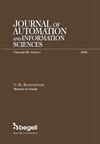测量和控制传递函数的误差转换
Q3 Engineering
Journal of Automation and Information Sciences
Pub Date : 2021-07-01
DOI:10.34229/1028-0979-2021-4-9
引用次数: 0
摘要
目前,电学和非电学量的测量是使用模数转换通道进行的,该通道由模拟信号调理电路和将电学量转换为数字代码的模数转换器(ADC)组成。本文考虑了测控通道的定义误差为模数转换器系统误差的情况。测量的可靠性是通过误差来评估的,而控制的可靠性是通过控制装置正确操作的可能性来评估的。我们认为,用不同的标准评价测量和控制等类似过程的可靠性似乎不合逻辑。工作的目的是研究模数转换器的系统误差对参数控制误差的影响,这取决于一致性函数的类型和控制窗口的宽度,以及各种控制任务的ADC分辨率的选择。本文对测控传递函数进行了分析。证明了它们是用阶跃函数形成的。建议不使用阶跃函数作为控制传递函数,而是使用符合范数的其他函数,例如线性函数或高阶函数。在这种情况下,对控制结果的评估不是根据正确操作概率的标准,而是使用控制误差。从重新配置的角度分析了直线、抛物线函数和状态抛物线函数的误差对开发变化窗口控制的规范。提出了一项建议,以选择符合标准的功能,并为工业控制企业分配模拟-数字转换。本文章由计算机程序翻译,如有差异,请以英文原文为准。
ERRORS CONVERSION ON TRANSFER FUNCTIONS OF MEASUREMENT AND CONTROL
Currently, the measurement of electrical and non-electrical quantities is performed using analog-to-digital conversion channels, which consist of analog signal conditioning circuits and analog-to-digital converters (ADC) of electrical quantities into a digital code. The paper considers the case when the defining errors of the measurement and control channel are systematic errors of the ADC. The reliability of measurements is assessed by their errors, and the reliability of control - by the likelihood of correct operation of the control device. In our opinion, evaluating the reliability of such similar processes as measurement and control using different criteria seems illogical. The aim of the work is to study the effect of systematic errors of an analog-to-digital converter on the errors of parameter control depending on the type of conformity functions and the width of the control window, as well as the choice of the resolution of the ADC for various control tasks. The paper analyzes the transfer functions of measurement and control. It is shown that they are formed using step functions. It is proposed to use not a step function as a control transfer function, but other functions of conformity to the norm, for example, a linear function or functions of higher orders. In this case, the control result is assessed not according to the criterion of the probability of correct operation, but using the control error. Analyzed from the point of view of reconfiguring the errors of the line, parabolic and state parabolic functions of the norms for the development of changes windows in control. A recommendation has been given for the selection of functions for the conformity of standards and for the distribution of analog-to-digital conversions for industrial control enterprises.
求助全文
通过发布文献求助,成功后即可免费获取论文全文。
去求助
来源期刊

Journal of Automation and Information Sciences
AUTOMATION & CONTROL SYSTEMS-
自引率
0.00%
发文量
0
审稿时长
6-12 weeks
期刊介绍:
This journal contains translations of papers from the Russian-language bimonthly "Mezhdunarodnyi nauchno-tekhnicheskiy zhurnal "Problemy upravleniya i informatiki". Subjects covered include information sciences such as pattern recognition, forecasting, identification and evaluation of complex systems, information security, fault diagnosis and reliability. In addition, the journal also deals with such automation subjects as adaptive, stochastic and optimal control, control and identification under uncertainty, robotics, and applications of user-friendly computers in management of economic, industrial, biological, and medical systems. The Journal of Automation and Information Sciences will appeal to professionals in control systems, communications, computers, engineering in biology and medicine, instrumentation and measurement, and those interested in the social implications of technology.
 求助内容:
求助内容: 应助结果提醒方式:
应助结果提醒方式:


